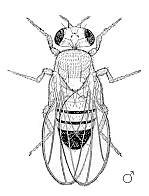Drosophila
|
|
| Drosophila | ||||||||||||
|---|---|---|---|---|---|---|---|---|---|---|---|---|
 Male Drosophila melanogaster | ||||||||||||
| Scientific classification | ||||||||||||
| ||||||||||||
| Species | ||||||||||||
Drosophila is a genus of small flies whose members are often called small fruit flies, or more appropriately vinegar flies, wine flies, pomace flies, grape flies, and picked fruit-flies. The genus contains about 1000 species. One species in particular, Drosophila melanogaster, has been heavily used in research in genetics and is a common model organism in developmental biology. Indeed, the terms "fruit fly" and "Drosophila" are often used synonymously with D. melanogaster in modern biological literature. This article however deals with the whole genus.
| Contents |
Name
The term "Drosophila" is a modern scientific Latin adaptation from Greek δρόσος, drósos, "dew", + φίλος, phílos, "loving" + Latin feminine suffix -a.
Physique
Typically, the small, two-winged flies of the genus Drosophila are an orange-brown color and range approximately from 3.2 mm to 4.2 mm in length. Most species have red eyes. The feathered arista is characteristic of the family.
Drosophila is part of the phylum Arthropoda, a phylum of segmented animals with paired, jointed appendages and a hard exoskeleton made of chitin. They have an open circulatory system with a dorsal heart, hemocoel occupies most of the body cavity, and coelom is reduced.
The insect respires by means of air-filled internal tubes, the tracheae. This ectoderm-derived organ forms a highly branched tubular network which provides the organs with oxygen.
Lifecycle and ecology
Habitat
Drosophila is found primarily in tropical regions. "The fruit fly, is a cosmopolitan holometabolous insect, that is found in all warm countries, while in cooler regions, it is established by migrants during the summer or can over winter in warm places." (Weigmann, 2003)
They appear on over-ripe fruit in kitchens, they swarm in thousands about the residue produced by the pressing of grapes or apples for wine. They nibble on marmalade and other preserves, and wherever vinegar is standing open, they are there.
Adult flies as well as larvae feed on the fruit juices and the yeast growing on rotting fruit. Most eggs live inside of the fruit along the peel of the fruit. "Some feed on other decaying organic matter or on plant exudations; a few are leaf miners, parasites, or predators." (Swan, 1972)
Reproduction
Drosophila_egg.png
"The female fruit fly lays batches of between 15 and 20 white eggs each day." (Burton) A female lays up to 2000 pearly white eggs, each with a pair of “wings” or respiratory “horns” near the anterior end; the eggs of all known Drosophila have one or more of these horns, the tips of which extend above the surface of the moist media in which the eggs develop.
Predators
One predator is the orchid mantis which feeds on free living insects, primarily fruit flies.
External links
- Fruit Flies in Space (http://www.nasa.gov/vision/earth/livingthings/03feb_fruitfly.html) NASA-supported researchers are going to send fruit flies to the International Space Station to learn what space travel does to the genes of astronauts
References
- Burton, Maurice. "Fruit Fly." International Wildlife Encyclopedia. 2002 ed.
- Freeman, Scott. Biological Science. New Jersey: Prentice-Hall, Inc., 2002.
- "Pomace Flies". Grzimek's Animal Life Encyclopedia, First Edition, 1969.
- Swan, Lester A., and Charles S.Papp. 1972. The Common Insects of North America: Fitzhenry & Whiteside Limited, Toronto. pp. 629
- Weigmann, K., Klapper, R., Strasser, T., Rickert, C., Teachnau, G.M., Jackle, H., Janning, W. and Klambt, C. (2003). FlyMove- A new way to look at development of Drosophila. pp. 19,310-311.de:Taufliegen

